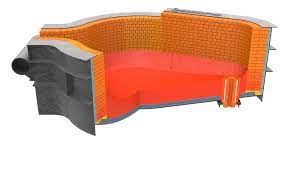
As a plant manager, you might need clarification about the exact process of a refractory installation. It's a complicated word, and you should know everything about it ahead of time to ensure the whole process goes smoothly.
There are many refractory installation companies to help you out, and we recommend you hire the best company in the field. You should know how to apply factory materials, including bricks, castables, and monolithic refractories. For proper installation, hiring experts is the best solution. They will take care of everything so that the installation is done in a cost and time-effective manner. There are five steps in the procedure to install a refractory. This method is reliable and very popular. You should follow the steps per experts' guidelines to obtain the best results.
Installation:
As mentioned above, it is essential to consult the experts first. During your consultation, they will help you assess the situation and determine how they can customize the process according to your requirements. They will conduct an industrial refractory installation. The process begins with mixing water and refractory clay.
Castable is a type of cement used in building and repairing furnaces, kilns, and other heat-resistant structures. Other than these, castable is popularly used in lining floors and walls. It is important to mix a certain amount of water with it. If the ratio of water to the refractory castable is inaccurate, the water will ruin the refractory lining. It will also lead to issues like lower strength and a longer time to set.
More water will be removed during the drying process, which will increase the cost and time taken to complete the process. It is essential to use the right amount of water; surprisingly, the type of water must be accurate. Both these factors are critical. The water should be clean.
Once you mix the castable with water, pour it within 30 minutes or the specified time as per the instructions. Do not use the castable if it's already set. Please note the process can vary depending on many factors. It is essential to consult the contractor and let them know if you are specifically looking for an electric arc furnace installation. This way, the contractor can make the desired changes to the procedure.
Curing:
After the installation, we must cure the refractory lining. In this stage, the water reacts with refractory cement, and the reef factory material hardens in its final form. The process is delicate since a lot of factors can impact it. For example, the temperature of the surroundings and castability can affect the curing process.
If the temperature exceeds the prescribed temperature, it will weaken the curing. Subsequently, it will take longer to cure. On the other hand, if the temperature is higher than recommended, the refractory product will heal quickly. The refractory lining might be unfit for application since a more elevated temperature tremendously affects the densification.
Temperature control:
Temperature is one of the most common factors that can ruin the process. It is crucial to control the temperature. Storing refractory materials and equipment under the specified temperature levels is essential. Sometimes contractors utilize heaters to help in the curing process. It all depends on the ambiance of the place.
If the equipment or materials are too cold, you will have to wait for them to reach the desired temperature. If the temperature is too cold or too hot, it will severely impact the curing process. It might as well disrupt the steps of installation.
Water removal:
Once the installation and setting are done, the next step is to remove the water. Contractors utilize various methods to apply heat and remove the water. This includes eliminating chemical and physical water.
It is essential to utilize the correct way since using the wrong method will increase the risk of spalls. The water will evaporate, but the steam might increase the internal pressure due to volume expansion. Hence, using the correct method to dry the water is crucial.
Drying:
It is the final step of the process. This step requires expertise and experience. There is a higher risk of cracking and weakening the refractory line if the drying out is not done correctly. Similarly, there is a higher chance of steam explosion. A steam explosion is dangerous for the workers and the project. It is essential to discuss the dry-out plan with the contractor beforehand.
During the drying-out process, you need to take care of many things. Keep an eye on the temperature; air and surface temperatures should be in the specified range. It is essential to have proper venting and circulation. Without free air circulation, the steam will exit the furnace shell, prolonging the time. It might as well lead to disintegration. Keep the drawing-out time short. Doing so will lead to more water retention, reducing strength. It will reduce the permeability if the drying process is completed quickly.
Conclusion
The above procedure is safe and efficient. But always remember that every factory project is unique. It is essential to discuss your requirements with a certified contractor. You can reach out to RHI if you need any help with refractory installation. A lot of factors can influence the procedure and the outcome. It is essential to hire a professional contractor who will overlook the entire process and make sure it is done correctly.
Once the installation process is over, you should take all precautions to maintain it. Repairing and maintaining the refractory lining installation to prolong its lifespan is essential. Repair or replace the damaged parts to avoid any refractory failures. Keeping the refractory will gradually increase its lifespan and help retain its efficiency. Always remember maintaining and repairing is a lot easier than fixing a refractory failure. It is cost-effective. If you don't know how to take care of your early factory, it is best to consult the experts or hire someone to take care of your refractory.